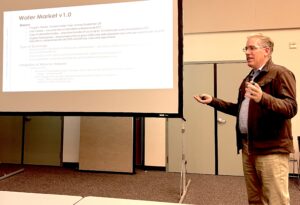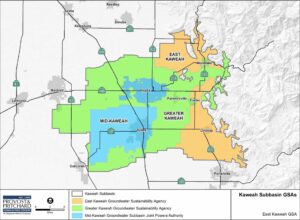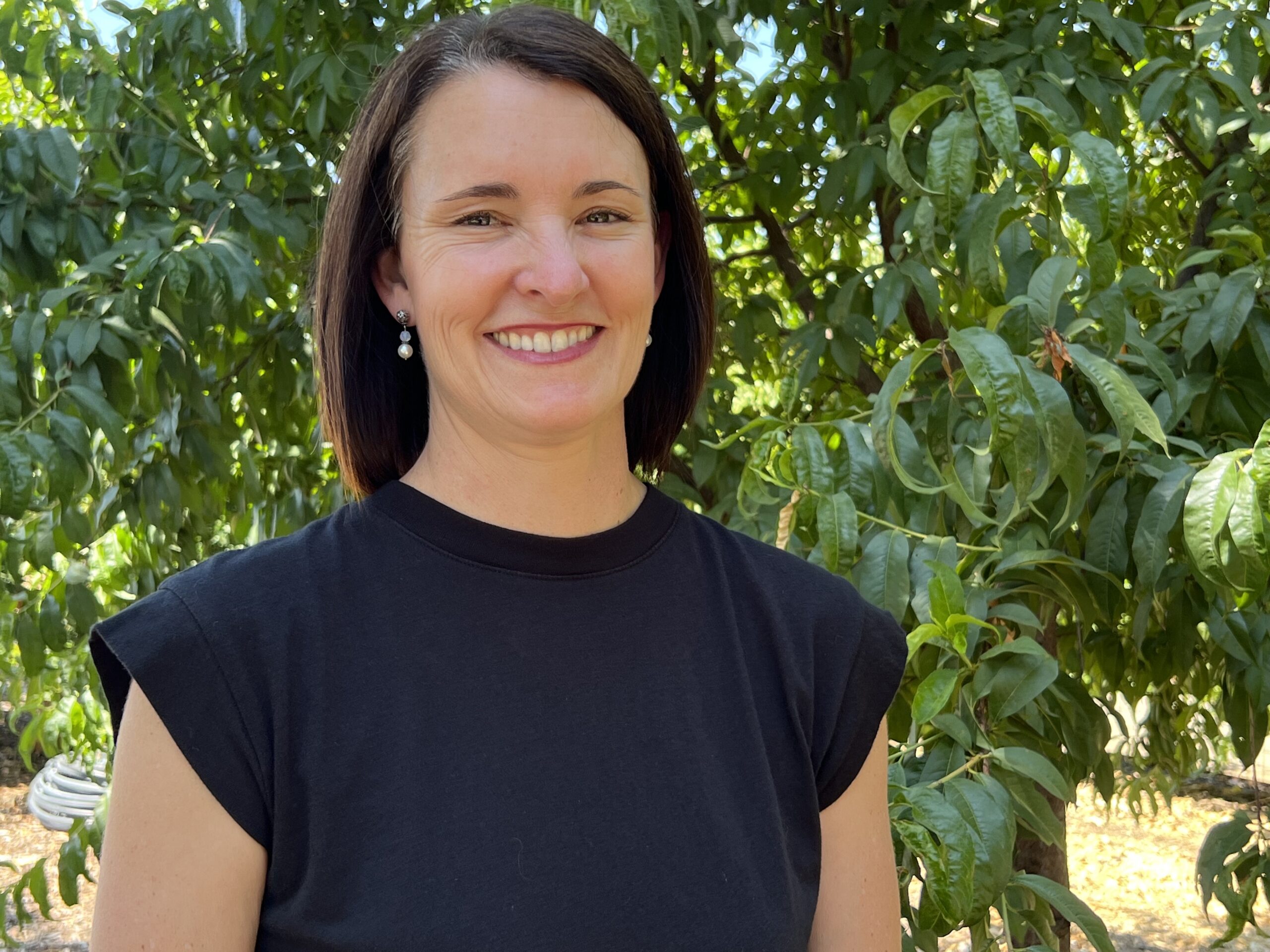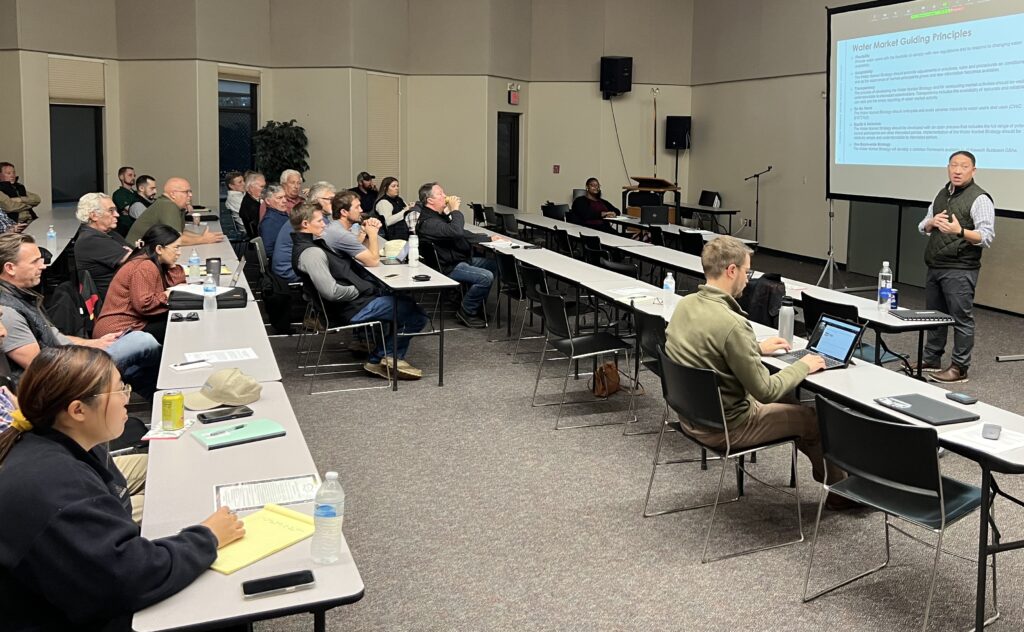How will selling groundwater help keep more groundwater in the San Joaquin Valley’s already critically overtapped aquifers?
Water managers in the Kaweah subbasin in northwestern Tulare County hope to find out by having farmers tinker with a pilot groundwater market program.
Kaweah farmers will be joining growers from subbasins up and down the San Joaquin Valley who’ve been looking at how water markets might help them maintain their businesses by using pumping allotments and groundwater credits as assets to trade or sell when water is tight.
There is a great deal of skepticism and concern, especially over possible harm to smaller farmers and vulnerable communities.
So far, Central Valley groundwater basins have only gotten to the tinkering stage.
“The eyes of California are on these markets,” Matthew Fienup told Kaweah farmers at a workshop in December. Fienup is a professor at California Lutheran University who helped design the software for the Kaweah pilot. Cal Lutheran also helped develop Fox Canyon’s market.

“We want to be very transparent. We will be sharing the quantity and price of actual transfers,” Fienup said.
Transparency is one thing, but Nataly Escobedo Garcia, water program policy coordinator with Leadership Counsel for Justice and Accountability, also wondered how Kaweah farmers can trade or sell something water managers haven’t done a good job of actually quantifying yet.
“It’s tough to trade when you don’t know what’s in the ground,” she said noting that many groundwater agencies are still trying to account for groundwater on their computer dashboards. “It poses a lot of issues when you can’t monitor folks properly.”
Beyond logistics, Escobedo Garcia said: “The commodification of water is not something we’re interested in seeing because there are other tools at a (groundwater agencies’) disposal that should be used first.”
Moving forward
Despite the obstacles, Mid-Kaweah Groundwater Sustainability Agency (GSA) is testing a water market in March.
It’s taken three years to implement the pilot project, funded by a $400,000 grant from the Bureau of Reclamation. And it will take more time to educate farmers and community members, acknowledged Mid-Kaweah GSA interim general manager Aaron Fukuda.
“There will be a lot of hand-holding while we get comfortable with this concept.”
Fukuda himself wasn’t a fan of water markets at first.
“Monetizing a resource had just too many issues with it. But when markets are done right, they are not a threat,” he said. But, “Farmers are going to need tools and farmers are the best at using tools to achieve the best outcome.”
The groundwater market being considered would only allow trading or selling between farmers in the same water district or groundwater agency.
That’s a much smaller subset of the overall water subbasin. For instance, the Kaweah subbasin has three groundwater agencies – the Mid-, East- and Greater Kaweah groundwater sustainability agencies.
Trading or selling groundwater between all those agencies would be much more complicated, but “The hope is to implement water markets throughout the Kaweah subbasin,” Fukuda said.
Trading and selling from subbasin to subbasin, such as the Kern subbasin to the Tule subbasin (southwestern Tulare County) or the Tule subbasin into the Kaweah subbasin, is more complicated still and, so far, not even in the pilot phase.
Though a report by the Public Policy Institute of California released last year said such interbasin trading could help reduce groundwater pumping and move scarce water supplies to the most valuable farmland and crops.
“For some basins with large internal differences in water availability, such as Turlock, Kings, Kaweah and Kern, achieving this level of trading would require substantial changes in practice, as well as some new infrastructure,” the PPIC report stated.
Others testing the water market
Madera County farmers participated in a similar water market pilot project in 2021.
As someone who has been in the trenches, Stephanie Anagnoson, Director of Water and Natural Resources for the county, said the pilots teach a lot of lessons, especially for those who farm areas that are outside of water districts and rely exclusively on groundwater. In the Madera subbasin, that adds up to more than 215,000 acres.
“A water market is a tool, but it depends on both trust and (pumping) allocations being in place,” she wrote in an email, citing a white paper by the California Water Commission. “Some growers are receptive to water markets, but there were a number of administrative hurdles. There are also GSAs actively hostile to a market.”
Despite its pilot project, Madera County GSA does not have a specific plan for a water market.
“I think a water market might happen a few years down the road,” she said.
In Rosedale-Rio Bravo Water Storage District in Kern County, a pilot project in 2018 funded by the Environmental Defense Fund helped lay some of the groundwork for a new, internal water market that is being developed.
A water accounting platform helped create a better understanding of water demand and supplies so landowners could make informed decisions regarding land use.
The platform, coupled with evapotranspiration data agreed upon by other Kern County GSAs is guiding the new market’s development, manager Dan Bartel said.
Bartel said the goal is to keep the market very simple for now — trades will occur on paper between buyer and seller as management anticipates only about 20 transactions per year. Adding more components, such as automated auctions, will not occur unless demand increases.
“It seemed like a lot and we have a small group of landowners involved,” Bartel said. “It seemed like more than what was necessary. But if a Kern County water market developed, with a bigger grouping I could see where that would be useful.”
Protecting disadvantaged communities
Looking out for all water users is key in the development of new groundwater markets, according to the Water Commission policy paper.
Effective enforcement of water market rules is a must — and a sticking point for Escobedo Garcia.
The software platform Mid-Kaweah will use acknowledges the possibility that groundwater hasn’t been properly quantified. The market will incorporate “buffer zones” to monitor whether groundwater levels near communities are dropping too low and would stop trades in that area.
Escobedo Garcia said that is not a fail-safe, given Kaweah water managers haven’t established a program to help fix drinking water wells that may go dry – a common occurrence in small communities through both of the last two droughts in Tulare County.
“What happens if someone’s well goes dry? Will they provide water or deepen a well?” she asked. “We are still addressing a backlog from the last drought. Are they prepared to take on the impacts of their actions?”
Will markets help?
It’s hard to know if markets will provide the flexibility farmers may need as the Sustainable Groundwater Management Act deadline of bringing aquifers into balance by 2040 moves closer.
Especially in the Kaweah subbasin where the three groundwater agencies have already failed to coordinate on everything from how data is collected to establishing agreed pumping limits.
Part of the problem is hydrology.

Both East and Mid-Kaweah have access to surface water via federal contracts through the Friant Water Authority, which they use to recharge groundwater. A large chunk of land in the Greater Kaweah GSA sits further west and has very little, or no, surface water, so many of its farmers are groundwater dependent.
Meanwhile, groundwater moves from east to west. So, at least a portion of whatever East and Mid-Kaweah farmers sock away in recharge eventually migrates to farmers in Greater Kaweah.
Which is why water managers are keenly interested in Mid-Kaweah’s market experiment.
A full intra-basin market would be “an organized way of associating unused (pumping) allocations to folks,” said East Kaweah GSA General Manager Mike Hagman. “Ultimately, it needs to happen based on establishing an open basis for trade.”
Greater Kaweah GSA manager Mark Larsen said all eyes are on the results of Mid-Kaweah’s pilot program.
“The challenge landowners express to me is they often don’t know how or where to find sellers or buyers,” he wrote in an email. “The water marketing tool looks to be the perfect venue to implement our transfer policy.
“A lot of thought and expertise went into developing this tool and I see Greater (Kaweah GSA) seriously considering it for inclusion.”
Share this:
- Click to share on Facebook (Opens in new window)
- Click to share on Twitter (Opens in new window)
- Click to share on LinkedIn (Opens in new window)
- Click to share on Reddit (Opens in new window)
- Click to share on Tumblr (Opens in new window)
- Click to share on Pinterest (Opens in new window)
- Click to share on Pocket (Opens in new window)
- Click to share on Telegram (Opens in new window)
- Click to share on WhatsApp (Opens in new window)
- Click to print (Opens in new window)









You must be logged in to post a comment.